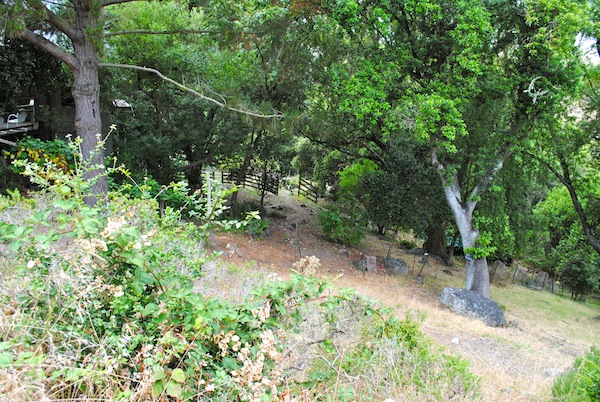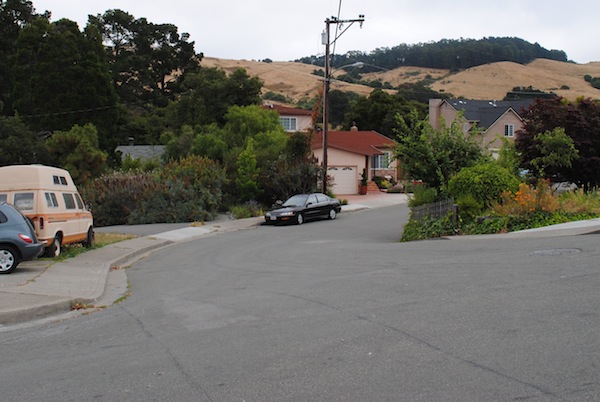More fires are reported on July 4th than any other day of the year in the United States, according to the National Fire Data Center.
Last year there were five wildfires in Richmond on the 4th of July. There were none this year but “We’re anticipating a lot today,” if people continue to use fireworks said battalion chief Erick Newman, who is on duty during this observed holiday.
The high numbers of fires during this holiday are usually the result of a combination of dry grass, brush and fireworks. But the danger of fire in Richmond doesn’t stop after Independence Day — fire season is just starting. Depending on weather conditions, the California Department of Forestry and Fire Protection determines when fire season begins. This year it started two weeks ago, in mid-June.

Residents need to trim overgrown grass and leaves. Photo by Veronica Moscoso.
“Usually when we have a late winter, we have a late summer and our fire season sometimes will go until November,” said Rod Woods, a firefighter who has spent 24 years working with the fire department in Richmond.
The Richmond Fire Department has always been pretty busy during fire season. Last year there were 72 wildfires in Richmond during this period. Because of this year’s long rainy season, there’s a serious threat of wildfires this summer. A wet winter leads to the growth of weeds and grass that dry out during the summer, raising the probability of a blaze, according to Woods.
Undeveloped areas in Richmond are susceptible to wildfire. Grass, weeds and brush grow out of control in open lots. Most of the undeveloped areas in Richmond are within East Bay Regional Park boundaries. These include — but are not limited to — Point Pinole, Alvarado Park, El Sobrante Ridge and Hills, Nichol Knob and Wildcat Canyon Park. “That probably hasn’t burned in years, so that means that there’s a lot of growth,” said Woods of Wildcat Canyon Park.

Communities surrounded by wildlands are at risk of wildfires. Photo by Veronica Moscoso.
However, areas where human development mix together with undeveloped wildland are also potentially in danger during fire season. Firefighters call these areas “wildland/urban interface.”
The Wildland/Urban Interface Fire Protection Program has identified four common components of interface fires:
1. Low relative humidity, high temperatures, and high winds often are in place before a fire starts.
2. Human activity such as arson, debris burning or downed electrical wires.
3. Many involve the destruction of homes were built with combustible material or have especially vulnerable features such as wood shingle roofs.
4. Considerable combustible materials surround the home, such as woodpiles and fences.
While environmentalists and foresters often believe that a natural fire is healthy for forests, and that fires in non-urban locations should be allowed to burn, homeowners in these areas expect fire protection of their structures.
One of the most destructive fires in the history of the United States was a wildland/urban interface fire. It occurred in October 1991 in the East Bay hills of Oakland; 25 lives were lost and more than 3,000 structures were destroyed.

View of an area of Richmond Heights. Photo by Veronica Moscoso.
Richmond has no record of a blaze of the magnitude of the Oakland Hills fire, “but we have the potential to have that though,” said Woods. “We have a lot of areas that are considered urban interface,” said Woods and cited the Richmond hills and the neighboring El Cerrito hills.
As a result of the Oakland hills fire, the Bates Bill (AB 337) was passed in 1992 requiring the California Department of Forestry and Fire Protection to work with local governments identifying “Very High Fire Hazard Severity Zones,” which are areas of the city considered to be the most at risk for wildfires. For the Contra Costa County map developed to show high-risk areas, click here.
These zones in Richmond include all of Point Richmond, Carriage Hills, and the El Sobrante Hills neighborhoods. Residents living in these areas are required by city ordinance to maintain adequate fuel and fire breaks between structures and flammable vegetation.
One side of the flyer the Richmond Fire Department hands out with the precautions to take during fire season.
Woods said that people that live in wildland/urban interface areas have to be especially careful to cut overgrown grass, trim leaves, clean pine cones on their roofs and remove anything that has potential to ignite during a fire.
In order to reduce potential fire hazards, the Richmond Fire Department hands out a flyer with a list of measures that residents who live in wildlife/urban interface areasneed to take in order to protect their property, including clearing dry grass, brush and other combustibles from at least thirty feet around each home.
According to CAL Fire, last year there were 4,657 wildfires in California that burned 80,990 acres.
The fire department hopes that Richmond residents, who live in high danger fire zones, take the necessary precautions to protect their property in the event of fire.
July 5, 2010 Richmond Confidential

